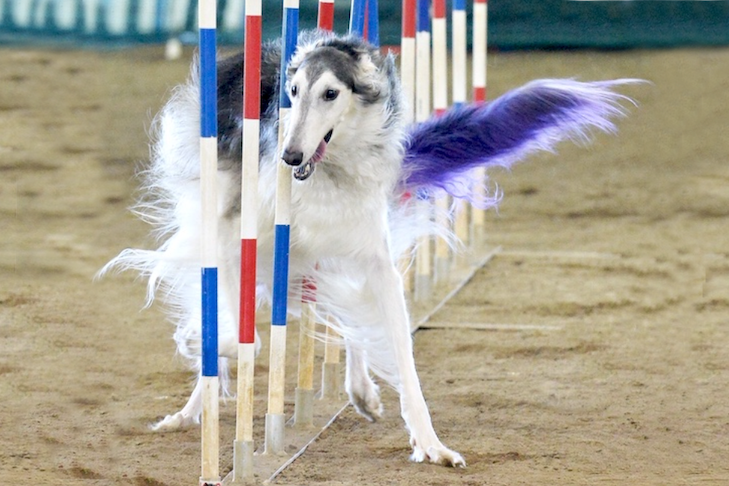If you’re watching your dog’s tail while they run or jump, you might think that this part of their body helps maintain balance and stability. However, a recent study from Cold Spring Harbor Laboratories suggests that dogs’ tails might not play as much of a role in their movements as we initially thought. Despite not yet having been peer-reviewed, this study drew some interesting points in how we think about why dogs use their tails. This doesn’t mean the tail is an unnecessary body part. Dog’s tails act as an important communication tool, not only between dogs and humans, but dogs and other dogs as well.
Does a Dog’s Tail Influence Their Movements?
Senior Professor at the German Institut für Zoologie und Evolutionsforschung at the Friedrich-Schiller-Universität Dr. Martin Fischer, who contributed to the study, has 17 years of experience studying canine locomotion (movement). “We were absolutely convinced that dogs used the tail for biomechanical reasons—at the beginning, at least,” he says.

The senior study author, Dr. Ardian Jusufi, is the Independent Group Leader of Animal Locomotion and Robotics at the Max Planck Institute for Intelligent Systems. “Since dog tails rotate similarly to what we found in lizards and squirrels, there’s a huge temptation to think they’re doing the same type of job as with the smaller vertebrates,” he says.
The large tails of lizards and squirrels play a big part in controlling movement, like body orientation or rotation. This isn’t surprising, considering their climbing and aerial jumping skills. But dogs don’t maneuver in the same, extreme ways. After extensive mathematical modeling and analysis of experimental data and simulations, the team behind the study realized that their initial thoughts on why dogs’ tails move this way were not adding up.
If Not Movement, What Is a Dog’s Tail Used For?
The study indicates that the tail makes little to no difference to a dog’s direction or change in direction when running or jumping. So if you thought your bob-tailed Australian Shepherd was at a disadvantage when competing in agility compared to a similar-sized Collie with a long tail, think again.
It is important to note that the authors of the study recognize that it has limitations, and the results are not black and white. Dr. Fischer and Dr. Jusufi suggest dogs could use the tail for what they refer to as “trim,” those very fine, almost invisible, one or two-degree fractional enhancements to movement. “It’s just very hard to show that experimentally with modeling because it has errors,” Dr. Jusufi says.

They also point out that the study focuses on observed data relating specifically to jumping Border Collies. This means that when the data was then modeled on a wider range of Canidae species, there could be subtle differences between dog breeds and sizes. So, for example, in tiny breeds with a significant tail, Dr. Fischer says that it might help to turn the dog around. This is because they have a larger tail index (the ratio of the tail to body length is greater). But for dogs with longer body lengths, the size of the tail tends to decrease, giving them a smaller tail index.
Why is the Tail So Important for Canine Communication?
While the study found that dogs’ tails aren’t likely to impact movement significantly, the authors say not to count it out completely. “We can’t gloss it over and say the tail is completely useless and totally vestigial,” Dr. Jusufi says. Vestigial structures are those that used to have a function in the past and now serve a different or little-to-no purpose, like the human appendix or wings on flightless birds.

As far back as their wolf ancestors, we know tails are important communication tools for dogs, and they might even help swat flies or other pests away. Where a dog’s tail is positioned can signal emotions to other dogs as well as humans.
“For example, a wagging tail does not necessarily indicate that a dog is happy or relaxed. It simply demonstrates arousal of some kind, which can be relaxed, happy, fearful, excited, or aggressive. Generally, the higher and faster the tail wag, the greater level of arousal. Conversely, low tail wagging or a tucked tail often signifies fear and/or appeasement,” says dog trainer and behavior consultant Mary Angilly.
Reading a Dog’s Body Language
Don’t just rely on the tail to assess what your dog is trying to say. You’ll need to consider their individual personality and other subtle dog body language signals. “While tail positioning and movement is an important factor when it comes to reading canine body language, it’s essential to look at a dog’s entire body—stance, eyes, ears, face, legs, etc.—and the context of the situation they’re in to determine what they are trying to communicate at any given moment,” says Angilly.

Even something as subtle as the direction of the tail wag could tell you something. “Some studies suggest that dogs more frequently wag to the left if they are fearful or worried and more frequently wag to the right if they are happy and relaxed,” Angilly says. She notes that if a dog’s tail is shorter, it might be harder to determine their body language, but other factors can help give context to what they’re trying to express.
While it seems less likely that dogs’ tails are used for movement, they are still a major part of their communication tools with humans, animals, and other dogs. Pay attention to your dog’s body language: they’re saying more than you might think!

